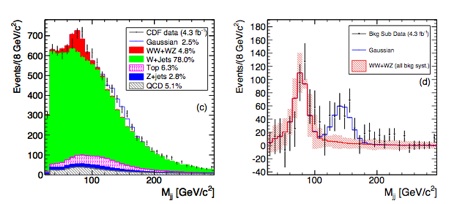Jon Butterworth has written an article in today’s Guardian that is truly a fabulous piece. I applaud it, not simply because of the pure facts, but also because he has demonstrated scientific integrity at its very best.
First, the core of the story itself is this …
This week the CDF experiment at the Tevatron proton-antiproton collider caused a stir with this paper and a special seminar. This is a common situation in scientific research. The result is (a) really important if confirmed and (b) in need of confirmation before everyone is certain of it.
If you want more than that standard summary, I’m going to try to justify parts (a) and (b). But first the data. The main plot in the paper is this:
Dijet mass distribution in W+jet events.
Jon then proceeds to explain in detail what this actually means. I’ll not repeat it all, instead I’ll give you a link below so that you can go read it all yourself.
Now, what I find is truly praiseworthy is that Jon does not do the usual tabloid thing of running off into la-la land by claiming this to be evidence for new physics. What he does do is to both successfully capture the excitement of this news and also mulls over other potential explanations …
There are a few reasons for the caution. Firstly there is a chance that this is just a statistical fluke.
… (details) …
Another worry is that neither the data nor the histograms are exact.
… (more details) …
My money is on the false alarm at the moment, but I would be very happy to lose it. And I reserve the right to change my mind rapidly as more data come in! That’s all part of the fun…
And that’s why its good science journalism, for not only do we find a precise clear description of what has been observed, but it has also been combined with a depth of honesty and integrity that is often sadly missing within many science stories, and as Jon himself observes, that truly is part of the fun.
OK, I promised you the link itself, so to read it all, here it is … enjoy.
